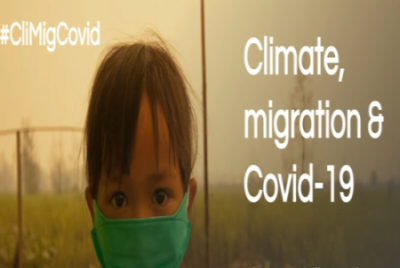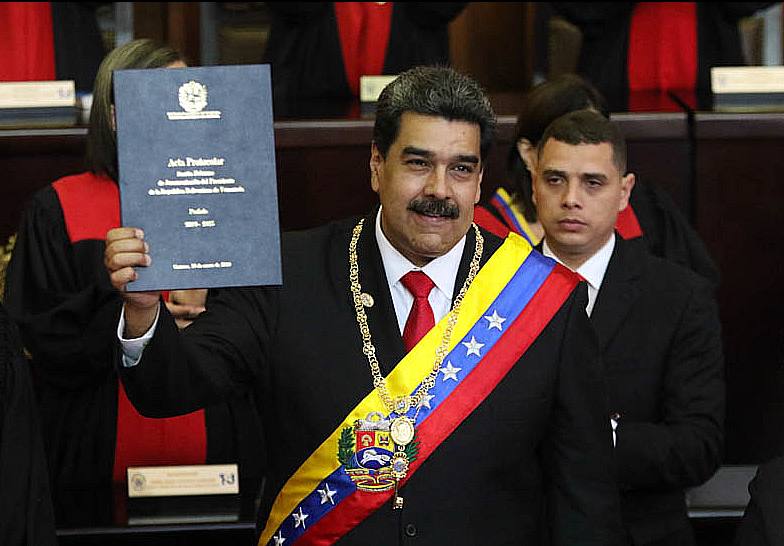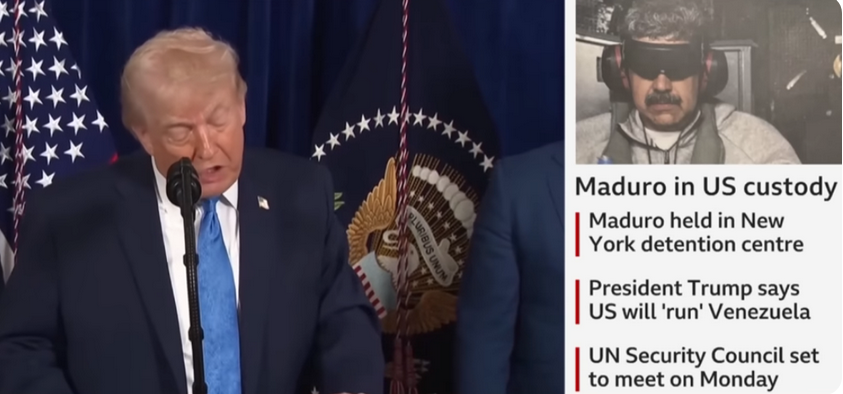[Future Hope Column]
“As people move further into the territories of wild animals to clear forests, raise livestock, hunt and extract resources [like oil and gas], we are increasingly exposed to the pathogens that normally never leave these places and the bodies they inhabit.”
Photo: YouTube
Does the emergence of the COVID-19 pandemic–in our time of climate change–forecast future disasters if the world doesn’t radically act and change now?
(I was recently asked to speak on a zoom call about the subject of “pandemics, climate change and extinctions” Since I knew very little about pandemics before COVID-19, I spent hours studying relevant articles I have saved over the last 45 days. I then put together the main content for that presentation in the form of quotes from these articles. Below is that compilation, followed by my thoughts about what we should be anticipating and doing given our current reality of economic recession/depression, piled on top of a worldwide pandemic, piled on top of accelerating climate change, piled on massive inequality and the systemic injustice and devastation caused by our capitalist economic system.)
From Arundhati Roy: “Nothing could be worse than a return to normality.
“Historically, pandemics have forced humans to break with the past and imagine their world anew. This one is no different. It is a portal, a gateway between one world and the next.
“We can choose to walk through it, dragging the carcasses of our prejudice and hatred, our avarice, our data banks and dead ideas, our dead rivers and smoky skies behind us. Or we can walk through lightly, with little luggage, ready to imagine another world. And ready to fight for it.”
Where did the COVID-19 come from?
Most immediately, it came from bats and/or other wild animals infected by them in the city of Wuhan in China, population 11 million. It was likely spread from the sale of wild animals for eating in an open market, possibly/probably with unsanitary conditions.
But this COVID-19 outbreak isn’t a unique situation, though the rapid spread of it all over the world is. What happened in Wuhan emerged out of what has been developing there and elsewhere for decades.
“While the virus was certainly not engineered in a laboratory, this doesn’t mean we haven’t played a role in the current pandemic. Human impingement on natural habitats, biodiversity loss and ecosystem degradation are making virus spillover events much more likely,” a major new study from scientists in Australia and the US has found.
“The number of emerging infectious disease outbreaks has more than tripled every decade since the 1980s. More than two thirds of these diseases originate in animals, and about 70% of those come from wild animals. Many of the infectious diseases we’re familiar with — Ebola, HIV, swine and avian flu — are zoonotic.
“As people move further into the territories of wild animals to clear forests, raise livestock, hunt and extract resources [like oil and gas], we are increasingly exposed to the pathogens that normally never leave these places and the bodies they inhabit.
“We’re getting closer and closer to wild animals,‘ says Yan Xiang, professor of virology at the University of Texas Health Science Center, ‘and that brings us into contact with these viruses.’
“In the last century, tropical forests, home to around two thirds of the world’s living organisms, have been halved. This profound loss of habitat has ripple effects throughout the entire ecosystem, including on the ‘parts we tend to forget — infections,’ says Hayman.” (1)
The issue of extinction of species is also involved.
“Another factor helping pathogens spread through the modern world is the preponderance of what ecologist Felicia Keesing calls ‘weedy species’ — this includes domesticated animals, as well as invasives like rats and mice, and even common species such as pigeons.
“These ‘weedy’ species have several characteristics in common. ‘They’re adaptable, they’re abundant, they tend to be small-bodied, and they reproduce quickly at a young age,’ she explains. ‘They have shorter life spans, so they have a lot of turnover in their populations. And they have attributes that we’re still trying to understand that seem to make them better reservoirs for many different diseases.’
“That’s why species going extinct and replaced in ecosystems poses a direct threat to humans. ‘The next emerging infection is more likely to come from a rat than from a rhino, right? We’re creating a planet in which the rats are thriving and the rhinos are disappearing, and when we create environments where those species thrive we’re absolutely affecting our health.’” (2)
Climate change and a warming world also encourages the spread of pathogenic diseases.
“First, warmer temperatures and more moisture are conducive to the accelerated reproduction of mosquitoes, including those carrying malaria, the zika virus, and other highly infectious diseases. Such conditions were once largely confined to the tropics, but as a result of global warming, formerly temperate areas are now experiencing more tropical conditions, resulting in the territorial expansion of mosquito breeding grounds. Accordingly, malaria and zika are on the rise in areas that never previously experienced such diseases.” (3)
“One of the reasons the human and animal worlds are bumping up against each other is a changing climate. Research suggests that warmer winters and springs are keeping bats, for example, around longer because the insects they feed on also like the warmth. And this may affect the spread of diseases bats carry.” (4)
Capitalism and its ever-expanding, ever-searching scramble for more resources, more things to use to make products to sell and make profit on, is very much at the root of all this.
“Economic globalization — that is to say, the accelerated free movement of finance and investment within a single world market where labor is relatively immobile and deprived of traditional bargaining power — is different from economic interdependence regulated by the universal protection of the rights of labor and small producers. Instead, we see a world system of accumulation that is everywhere breaking down traditional boundaries between animal diseases and humans, increasing the power of drug monopolies, proliferating carcinogenic waste, subsidizing oligarchy and undermining progressive governments committed to public health, destroying traditional communities (both industrial and preindustrial) and turning the oceans into sewers. Market solutions leave in place Dickensian social conditions and perpetuate the global shame of income-limited access to clean water and sanitation.” (5)
Deforestation, also caused by capitalism’s voracious search for new resources to sell, as well as by the growth in the human population, now about 7.5 billion compared to 1.2 billion at beginning of 20th century, are major drivers of climate change. There are less trees and other vegetation to absorb carbon in the atmosphere, and more people in need of everything that humans need to survive.
“Combined with mechanized agriculture and deforestation, climate change is also undermining subsistence farming and indigenous lifestyles in many parts of the world, driving millions of impoverished people to already crowded urban centers, where health facilities are often overburdened and the risk of contagion ever greater. ‘Virtually all the projected growth in populations will occur in urban agglomerations,’ the IPCC [Intergovernmental Panel on Climate Change] noted. Adequate sanitation is lacking in many of these cities, particularly in the densely populated shantytowns that often surround them. ‘About 150 million people currently live in cities affected by chronic water shortages, and by 2050, unless there are rapid improvements in urban environments, the number will rise to almost a billion.’
“Such newly settled urban dwellers often retain strong ties to family members still in the countryside who, in turn, may come in contact with wild animals carrying deadly viruses.” (6)
I’m going to end this section with quotes from science journalist and author Sonia Shah in The Nation:
“Habitat destruction threatens vast numbers of wild species with extinction, including the medicinal plants and animals we’ve historically depended upon for our pharmacopeia. It also forces those wild species that hang on to cram into smaller fragments of remaining habitat, increasing the likelihood that they’ll come into repeated, intimate contact with the human settlements expanding into their newly fragmented habitats. It’s this kind of repeated, intimate contact that allows the microbes that live in their bodies to cross over into ours, transforming benign animal microbes into deadly human pathogens.
“Similarly, the expansion of suburbs into the Northeastern forest increases the risk of tick-borne disease by driving out creatures like opossums, which help control tick populations, while improving conditions for species like white-footed mice and deer, which don’t. Tick-borne Lyme disease first emerged in the United States in 1975; in the past 20 years, seven new tick-borne pathogens have followed.
“But many more [animals] are reared in factory farms, where hundreds of thousands of individuals await slaughter, packed closely together, providing microbes lush opportunities to turn into deadly pathogens. Avian influenza viruses, for example, which originate in the bodies of wild waterfowl, rampage in factory farms packed with captive chickens, mutating and becoming more virulent, a process so reliable it can be replicated in the laboratory. One strain called H5N1, which can infect humans, kills more than half of those infected. Containing another strain, which reached North America in 2014, required the slaughter of tens of millions of poultry.
“The avalanche of excreta produced by our livestock introduces yet more opportunities for animal microbes to spill over into human populations. Because animal waste is far more voluminous than croplands can possibly absorb as fertilizer, it is collected in many places in unlined cesspools called manure lagoons. Shiga toxin–producing Escherichia coli, which lives harmlessly inside the guts of over half of all cattle on American feedlots, lurks in that waste. In humans, it causes bloody diarrhea and fever and can lead to acute kidney failure. Because cattle waste so frequently sloshes into our food and water, 90,000 Americans are infected every year.” (7)
So what does all of this mean?
What should we be anticipating and doing given our current reality of economic recession/depression piled on top of a worldwide pandemic piled on top of accelerating climate change piled on massive inequality and the systemic injustice and devastation caused by the world-dominant, capitalist economic system?
++Regarding climate change, it’s important to know that coal, oil and gas are all in very big trouble, and renewables are surging, despite many Democrats still supporting fracking and Trump Republicans trying to turn the clock back 50 years. The economics of shifting to renewables and the politics of a massive and determined climate justice movement are having a very decided impact that needs to rapidly accelerate.
**Because of the economic downturn, there will be a resurgence of organized action by the unemployed, by tenants, by masses of people facing evictions, mortgage foreclosures and utility and water shutoffs, by people who are hungry (food riots?). Because of the growth of the Left over the past 5-10 years, seen most dramatically and massively by the Sanders “Not me, us” campaign of 2019-2020, we are in a position to strengthen and connect these organizing efforts.
++The support for a Green New Deal, Medicare for All, a $15 minimum wage, a massive new housing for low-income and working-class people and other such policies can and need to keep growing and leading to victories. The exposure of the bankruptcy of both Republican and corporate Democrat approaches on these issues by the Sanders and Warren campaigns and the Left generally has laid the basis for that to happen.
These issues interconnect. Here’s what Canadian writer and labor activist Sam Gindin wrote along these lines:
“Most generally, if we win and consolidate the healthcare principle of “from each according to ability to pay, to each according to need” (with ability to pay determined through a progressive tax structure), that victory would be an inspirational and strategic boost to extending socialized medicine’s core principle throughout the economy.” (8)
++The concepts of nationalization and socialization of many things that right now are in the control of transnational corporations and greedy capitalists are already beginning to come forward. At least two major climate action groups, Food and Water Action and Oil Change International, have come out in the last month in support of the need to seriously consider this as a key solution to climate destruction.
++I would expect that there will be increasing calls for land reform to remove land ownership from corporate hands and put it into the hands of people in need who can begin to reverse deforestation and the dominance of corporate agriculture, move our systems of food production toward much more locally-based, organic and cooperative, plant-based and vegetarian ways of producing healthy food, as well as forest-based and other medicinal plants.
Finally, just a few thoughts on immediate tactics.
First, we absolutely must remove Trump from office, and support efforts to shift the Senate into control by Democrats. Trump must go, and any effort to equate Trump and Biden as the same, as “equally terrible” as some of the Left described Clinton and Trump, must be rejected and opposed, because it’s not true.
Secondly, we must continue to build the electoral and non-electoral, issue-based and grassroots-organizing movement of movements that loosely exists already, and in whatever ways we can strengthen its connections and coordination.
And finally, as we do all of this work, we must consciously hold up the importance of and actively build a solidarity, love-based culture of organizing. We must learn from the history of past efforts at systemic change which have floundered because they were male-dominated, monochromatic instead of consciously multi-racial, led too often by white men who too often got wrapped up in ego and power. We won’t change society if we don’t reflect in the way we work a very different, non-individualistic, non-capitalist set of values as we interact with each other and with others we are reaching out to.
The numbered references used in this article correspond to the following:
1) Coronavirus Pandemic Linked to Destruction of Wildlife and World’sEcosystems, Charli Shield
2) By John R. Platt, The Revelator 03 April 20
3) Michael T. Klare , April 2, 2020, TomDispatch
4) Skodt McNaalty CBC News · Posted: Jan 31, 2020
5) Mike Davis On Pandemics, Super-capitalism and the Struggles of Tomorrow
6) COVID-19 and Circuits of Capital, Rob Wallace, Alex Liebman, Luis Fernando Chaves and Rodrick Wallace, March 27, 2020, Monthly Review
7) Sonia Shah in The Nation, Think Exotic Animals Are to Blame for the Coronavirus? Think Again. Feb 18, 2020 8) The Coronavirus and the Crisis This Time, Sam Gindin (Canada)
https://tedglick.com/future- hope-columns/pandemics- climate-crisis-and-the- turbulent-future/







